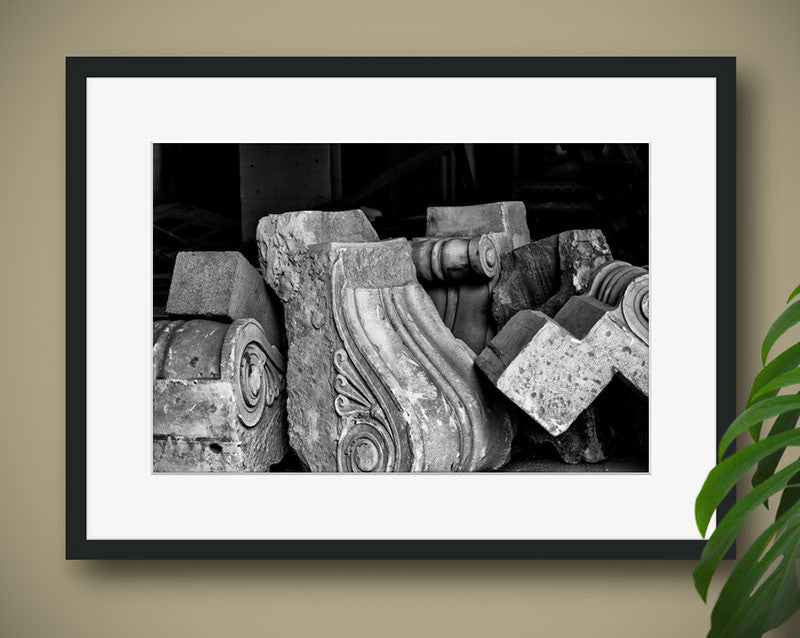
Thoughts on photography: Photographer Keith Dotson's personal column about the art and business of fine art photography
Art is a very subjective topic of course, but since I specialize in black and white photographs, I thought I’d describe the qualities I believe make a great black and white image. For me, it comes down to four elements:
- Emotion
- Unique vision
- Story
- The print
Notice that I didn’t mention anything about focus, composition, or the type of camera used to make the image. Those things matter, but they’re basics that fall secondary to the artist’s unique vision. Russian hermit Miroslav Tichý made thousands of beautifully evocative (if not somewhat pervy) images of young women with cameras he made out of junk, including cardboard tubes.
Black and white photograph of an abandoned antique delivery truck, found in a ditch on a backroad. This print is mounted and ready to be packed for shipping to a client.
Emotion
I believe B&W photography is particularly well-suited to portraying emotion in the subject, as well as provoking emotion in a viewer. One of the reasons I’m so passionate about the art of black and white photography is its combination of both raw power and subtlety, its grain and texture — the way it cuts away the superficial stuff and gets us to the essence of a subject.
While a color photograph may show us reality, a black and white photograph shows us truth. Author Ted Grant said it well: “When you photograph people in colour, you photograph their clothes. When you photograph people in black and white, you photograph their souls.” Grant’s statement applies to landscape photos as well, and yes, I believe landscapes often have “soul.” Regardless of the subject — whether it’s a stranger on a city sidewalk in the 1950s Chicago street photographs of the late Vivian Maier, or a foggy mountaintop in China in the singular landscapes of Michael Kenna — a great B&W photograph conveys emotion.
Unique Vision
The unique vision of the artist is what gives all art its power. In photography, this involves many choices, not only of subject matter and themes, but also of lighting, equipment, and techniques. In the hands of an artist, a beautiful photograph may be too dark or too light, it may be blurry, or it may be oddly composed. The photograph may be created in a wooden box camera on a glass plate negative using antique lenses, or it may be created in a pinhole box with no lens at all. It may be a digital file processed on a computer, or a salt print processed the same way it was done 150 years ago. The process serves the vision of the artist and over time becomes a signature style. An Ansel Adams landscape is unmistakable, just as a fashion photograph by Richard Avedon is uniquely his own.
I’ve found that minimalist compositions often result in my most effective and evocative B&W images: a single blackbird in flight, contrasted against a snow-covered field; a barren winter tree separated from the background by a dense, mysterious fog; a few droplets of dew slowly running down a thread of spider silk on a damp morning. One of my most popular photographs features nothing more than abstracted ripple patterns in a languid stream.
Story
A good photograph usually tells (at least a piece of) a story, and is often part of a continuum of the artist’s work that expands on a theme. Of course, this is unique to each photographer and connects directly back to their vision. For some it might be family issues, for others it might be exploration of a certain culture or subculture, and for others it might be nature. My work tends to include two running themes:
- My belief that all art springs from nature and that the natural world is an endless source of inspiration and beauty; and
- The idea that most landscapes are more than just landscapes, having been shaped by their histories and the people who lived, worked, or died there. What happened there? Who walked that ground long before we did? I can almost literally feel the voices of those people from the past trying to speak through my images. B&W photography is perfectly suited for communicating this kind of story.
A high-quality print
For B&W photography in particular, the final goal should still be a high-quality print. The print is the ultimate expression of the photographer's vision. Photography is ubiquitous these days, and most people experience photos on the Internet. But a B&W photograph must be seen in print. Prints come in a wide variety of formats, from pigment prints on watercolor paper or canvas, to traditional silver gelatin photographic prints, and even all types of historic or "alternative prints." Regardless of the format, a beautifully framed B&W photograph should take your breath away.

This image shows the delicious texture of a museum-quality silver gelatin fiber-based baryta print.
It should serve as a conversation piece or as an enhancement to your interior design. I receive amazing feedback from collectors, who often say that my work has touched them in a profound or meaningful way. I love hearing that because I want to create photographs that move people. But I also want to create images that people are proud to frame and display in their homes or offices. That’s how I know I’ve created a successful black and white photograph.
Those are my thoughts. What do you look for in a great photograph?
— Keith


Leave a comment